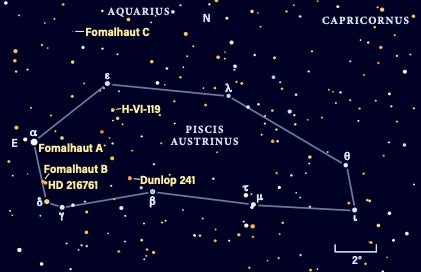The autumn sky is not known for bright stars. True, we are still enjoying the brilliant leftovers from the summer early in the evening and the dazzling winter stars toward midnight. But the autumn sky itself is home to only one truly bright star.
Crawling along our southern horizons this month is the season’s brightest sun, Fomalhaut (Alpha [α] Piscis Austrini), the “mouth of the whale.” Fomalhaut is only about 25 light-years away and is the 18th brightest star in the sky. It outshines old favorites like Deneb (Alpha Cygni) and Castor (Alpha Geminorum), yet few people give it more than a passing glance, if any at all. That’s probably due to its low location in most northern skies.
That isolated position, however, makes finding Fomalhaut a snap. Just head out any October evening and look close to the southern horizon. It’s the brightest star — maybe the only star — you’ll see in that direction. At midmonth, it crests above the horizon, or culminates, at 10 P.M. local daylight time.
Fomalhaut is a brilliant white spectral type A star. But when you raise your binoculars its way, it may look more like a colorful strobe. That vibrant display is caused by turbulence in Earth’s atmosphere, which is further amplified by the star’s low altitude.
Fomalhaut is actually a triple-star system. The brighter companion star, 6th-magnitude Fomalhaut B, is nearly a light-year away from Fomalhaut A, placing it almost 2° to its south in our sky. Fomalhaut B is an orange dwarf sun also known as the variable star TW Piscis Austrini. Over a 10.3-day period, it varies in brightness slightly from magnitude 6.44 to 6.51. While that is too subtle to detect through binoculars, you should notice the star’s golden tint. In fact, you’ll probably see two colorful stars there. The second, HD 216761, lies just 8′ southeast of TW and is half a magnitude brighter. Although they are nowhere near each other in space, they do form a lovely optical double through binoculars.
And for the record, the system’s third member, Fomalhaut C, is a 13th-magnitude red dwarf more than 5° to Fomalhaut A’s northwest.
Fomalhaut draws our attention to the dim constellation Piscis Austrinus the Southern Fish. You’ll find its outline, which reminds me more of a pickle than a fish, along the southern edge of this month’s Star Dome. None of the Fish’s other stars crack 4th magnitude, so beginning at Fomalhaut, use your binoculars to trace out the constellation.
If you’re game for a challenge, pause when you come to Beta (β) Piscis Austrini and take a close look. Beta is a binary star, pairing a magnitude 4.3 primary star with a magnitude 7.8 companion just 30.3″ south. That’s barely resolvable with 10x binoculars under ideal conditions. But with it so low in the sky, more magnification may be required to ferret it out.
If splitting Beta is a bit much, there is an easier double star hiding in plain sight 1.3° to the northeast. Dunlop 241 was discovered by 19th-century Scottish astronomer James Dunlop and included in his 1829 compilation Approximate Places of Double Stars in the Southern Hemisphere. Often abbreviated Δ241 on charts, Dunlop 241 is made up of two golden K-type suns. The system’s brighter primary star shines at magnitude 5.8, while its fainter cohort is magnitude 7.8. You’ll enrich their subtle colors by slightly defocusing the view.
Let’s hunt down one final double star in the Southern Fish. Scan across the Fish’s form to Epsilon (ε) Piscis Austrini, 6° northeast of Beta. As you do, keep an eye out for H-VI-119, another pretty and underappreciated pair. First published in volume 6 of William Herschel’s double star catalogs of 1782 and 1784, H-VI-119 consists of magnitude 6.4 and 7.5 stars. Take a close look and you’ll see that the primary is a rich yellow color, while the secondary is a delicate blue.
Do you have any questions, comments, or suggestions for future targets? Please contact me through my website, philharrington.net. Until next month, remember that two eyes are better than one.










